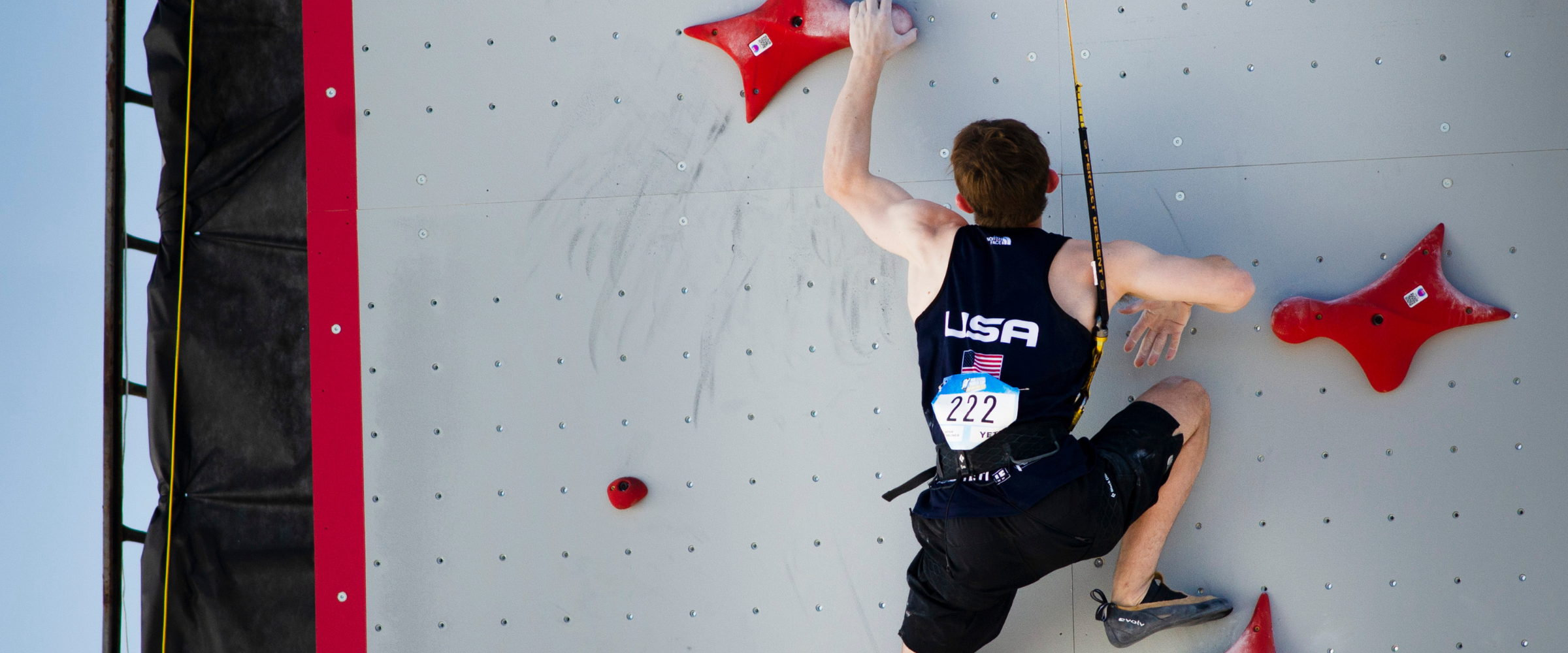The Beginner's Guide to Speed Climbing

As a former sprinter (in the sports of swimming and track and field), I am completely fascinated by the sport of speed climbing.
Speed climbing is arguably the fastest race-based event between two or more humans. The current world record for men’s speed climbing is 4.74 seconds, and the women’s world record is 6.06 seconds. The world record for the men’s 100-meter track race is 9.58 seconds, and the women’s is 10.49 seconds. Those times nearly double the speed climbing times.
Article At A Glance |
|
Speed climbing isn’t exactly a new concept.
Climbers have been technically racing each other, especially on El Capitan, for decades. One of the most notable speed climbing routes is The Nose in Yosemite. First accents are no longer the most coveted accomplishment in climbing–being the fastest to climb a route has also become a competition-based avenue.
In the realm of indoor competitive climbing, speed climbing is an anomaly.
Whereas bouldering and sport climbing follow an onsight format, speed climbing is extremely consistent and precise. Bouldering and sport routes are ever-changing, the same routes are never repeated. The speed climbing wall has been the exact same since 2005. Same hand holds, same foot chips–all positioned in the same t-nuts at the exact same angles on a 15-meter length wall with a 5-degree overhang.
All regulation speed walls must be built and set to the exact standards of the IFSC. The only real variance from gym to gym is the speed timer system and auto-belay manufacturers being used. Naturally, the age of the holds and the wear and tear on both the holds and the wall over time has a minor impact on the quality of the wall. But this doesn't matter as much for the average indoor climbing gym hosting a USAC regional QE.
When climbed statically, the speed wall has a YDS grade of 5.10c. It is hard to climb the route slow let alone to climb it fast.
Training for Speed Climbing
Technically speaking, the route never changes–but there are different ways or beta for climbing it. There are exactly 20 hand holds, and 11 foot holds. Every seasoned speed climber knows that you don’t touch handhold number 17 (essentially, the 4th hold from the top). The preferred beta is to grab the 11th foothold instead, before moving into the final cluster of three hand holds. The newest trend is to skip handhold number 4 (and foothold number 3), by completing a dyno called the “Tomoa Skip”--coined after the Japanese rock climber, Tomoa Narasaki.
Essentially, climbers move off the two start holds, grab the third hand hold with both hands, step up onto the same hold with the left foot (smearing with the right foot), and dyno to hold number 5–in one fluid, super-fast motion. This move single-handedly revolutionized the speed climbing start.
The best speed climbers train the wall in chunks–dialing in every hold grab, step, and smear section by section. Each hold on the wall has a preferred beta–an exact spot to grab or step. Smearing is a crucial technique in speed climbing, and many foot holds get skipped. Precision is everything.
In training, the wall gets broken up into three sections–the start, the middle, and the finish. The middle is arguably the easiest section, the smoothest to move through. I would venture to say that most speed climbers focus on training the start and the finish, in individual parts. After all, these sections are the places where the most time can get shaved off.
Slips are the enemy of the speed climber, and they can happen at any point in the route. A climber can usually recover from small slips or brief moments of instability if they are still connected to the wall. A small slip might cost a climber a fraction of a second, depending on how fast they can recover. Larger slips can lead to a full loss of control and momentum, forcing the climber to lose contact with the wall and forfeit the run altogether.
Scoring Speed Climbing
The competition format for speed climbing is unique when compared to most race-based sports. A standard 400-meter running track typically has eight lanes, the same as an Olympic-sized swimming pool. Both sports allow 8 athletes to compete side-by-side. In speed climbing, there are only two lanes–Lane A and Lane B.
Speed climbing competitions start with a qualification round, which includes three separate runs for each climber.
First, each climber will run two separate runs against the same opponent for time. Each climber will run once in each lane on the wall, essentially swapping sides with the same opponent. In this phase, the athletes are not competing against each other, per se, but the clock. The goal is to run a time fast enough to qualify for and get a good seed for the third and final run of the qualification round. Typically, the climbers with the top 16 times will move on to the third and final qualification run.
The third and final run in the qualification round marks the start of the knock-out format. All runs from here on out will follow this format. The heat in which a climber runs the third run of the qualification round depends on the best time from the two previous rounds, as well as their overall ranking (as compared to the others in the field).
The third qualification round is a head-to-head knock-out. At this level, running the fastest overall time isn’t as important as beating the climber in the next lane. To advance to the quarter-finals, you have to beat the person next to you. If you lose your head-to-head match, you’re out. It doesn’t matter if you run a faster time than climbers in the other heats. If you get knocked out, that’s it.
The winners of each quarter-final heat will advance to the semi-finals. As before, the times of the winners in the quarter-finals will determine their rank and heat placement in the semi-finals.
Before we go any further, let’s bring in some numbers. Let’s say that 16 athletes qualify for the competition. All 16 athletes will run two qualification runs–the goal is to run the fastest times, and losing to your opponent is completely fine. All 16 athletes will then move on to the third and final qualification run. These athletes go head-to-head in eight runs of two climbers–winners move on, and losers get knocked out. The eight winners of the qualification rounds advance to the quarter-finals, which consists of four runs of two climbers. The four winners of the quarter-finals advance to the semifinals, two runs of two climbers.
And this is where things get a little weird.
The semifinals are not a knock-out round, but a qualifying round for the final round. The goal is still to win and beat your opponent–but if you lose you still have a chance to win a medal. The two winners from the semi-finals will move on to the big final, and their losing opponents will move on to the small final. The climbers in the small final will fight for the bronze medal (and 4th place), while the climbers in the big final battle it out for gold and silver.
In these two rounds, winning the head-to-head is the only thing that matters. Even if the climber in the small final runs the fastest time in the Olympics and breaks the world record, that climber will only qualify for a bronze medal.
And yes, that is exactly what happened at the 2024 Paris Olympics.
Sam Watson from the USA ran a world-breaking time of 4.75 seconds in the small final. But because he was in the small final, the fastest speed climber in the world placed third at the Olympics, with the fastest time ever recorded in speed climbing history.
In any other time-based sport, being the fastest usually means gold–but speed climbing is kind of an outlier in this regard. Is there a world where we have more than two lanes of speed climbing running at the same time? Four lanes? Maybe eight? Who knows.
I would like to see this sport progress beyond the two-lane format, but I also don’t know how realistic it is to expand it any further. I guess, time will tell!
Tell Us What You Think
We're revitalizing and re-imagining our content program here at the CWA. Take two minutes to tell us what you thought of this article in an anonymous survey.
About the Author
 Ashley Routson is the General Manager of Planet Rock Climbing Gyms in Madison Heights, MI. She is a proud graduate of THE Ohio State University, where she was a member of both the varsity swimming team and varsity rowing team. Ashley came to the indoor climbing industry after nearly two decades of working in the restaurant and craft beer industries. She is also the author of The Beer Wench's Guide to Beer--a comprehensive book detailing all things craft beer. When she isn't pulling on plastic rocks in the gym, Ashley loves moderate trad and sport climbing in the great outdoors.
Ashley Routson is the General Manager of Planet Rock Climbing Gyms in Madison Heights, MI. She is a proud graduate of THE Ohio State University, where she was a member of both the varsity swimming team and varsity rowing team. Ashley came to the indoor climbing industry after nearly two decades of working in the restaurant and craft beer industries. She is also the author of The Beer Wench's Guide to Beer--a comprehensive book detailing all things craft beer. When she isn't pulling on plastic rocks in the gym, Ashley loves moderate trad and sport climbing in the great outdoors.

